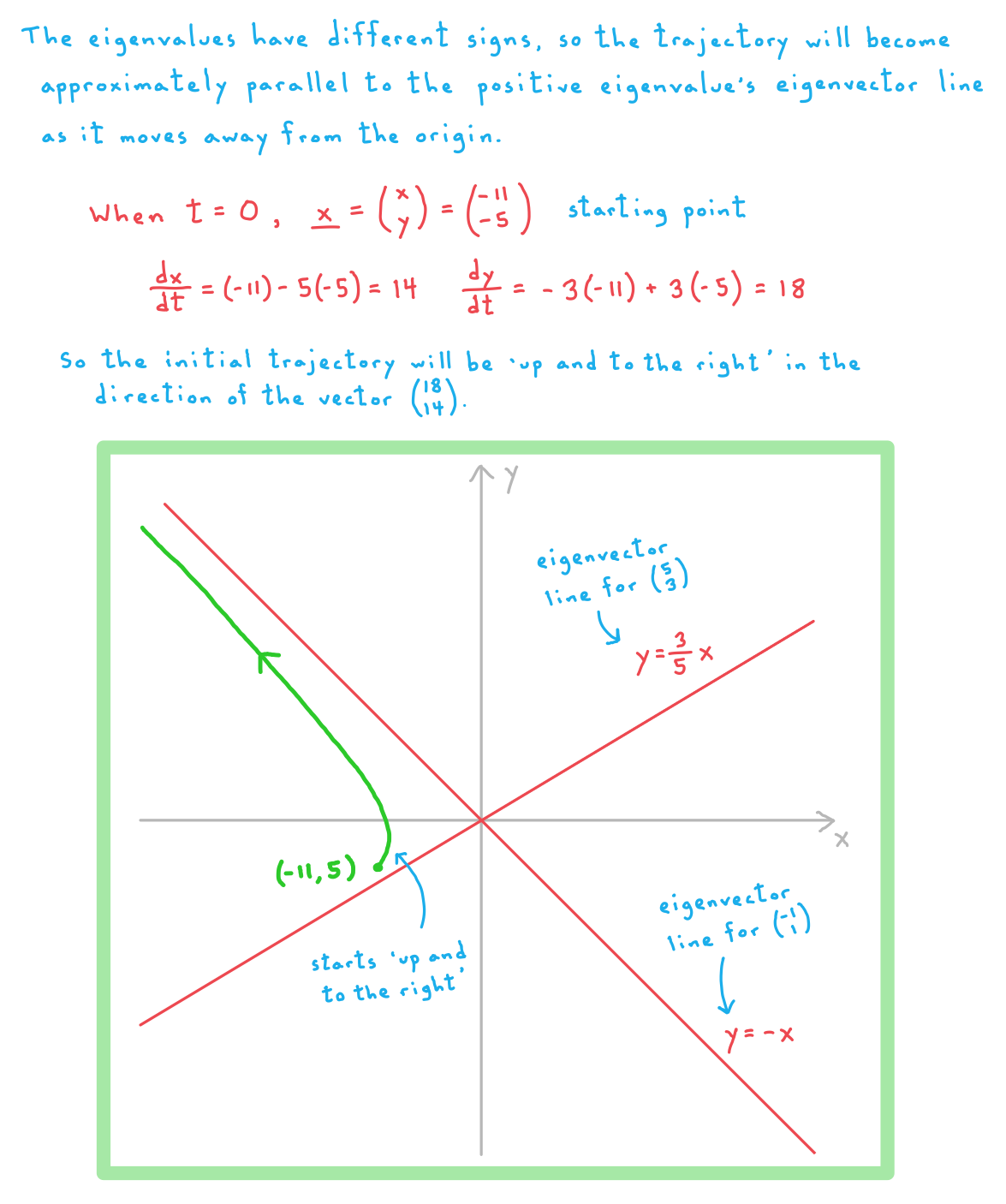Solving Coupled Differential Equations
How do I write a system of coupled differential equations in matrix form?
- The coupled differential equations considered in this part of the course will be of the form
-
-
are constants whose precise value will depend on the situation being modelled
- In an exam question the values of the constants will generally be given to you
-
- This system of equations can also be represented in matrix form:
- It is usually more convenient, however, to use the ‘dot notation’ for the derivatives:
- This can be written even more succinctly as
- Here
,
, and
- Here
How do I find the exact solution for a system of coupled differential equations?
- The exact solution of the coupled system
depends on the eigenvalues and eigenvectors of the matrix of coefficients
- The eigenvalues and/or eigenvectors may be given to you in an exam question
- If they are not then you will need to calculate them using the methods learned in the matrices section of the course
- On the exam you will only be asked to find exact solutions for cases where the two eigenvalues of the matrix are real, distinct, and non-zero
- Similar solution methods exist for non-real, non-distinct and/or non-zero eigenvalues, but you don’t need to know them as part of the IB AI HL course
- Let the eigenvalues and corresponding eigenvectors of matrix
be
and
, and
and
, respectively
- Remember from the definition of eigenvalues and eigenvectors that this means that
and
- Remember from the definition of eigenvalues and eigenvectors that this means that
- The exact solution to the system of coupled differential equations is then
- This solution formula is in the exam formula booklet
are constants (they are essentially constants of integration of the sort you have when solving other forms of differential equation)
- If initial or boundary conditions have been provided you can use these to find the precise values of the constants
and
- Finding the values of
and
will generally involve solving a set of simultaneous linear equations (see the worked example below)
Worked Example
The rates of change of two variables, and
, are described by the following system of coupled differential equations:
Initially and
.
Given that the matrix has eigenvalues of
and
with corresponding eigenvectors
and
, find the exact solution to the system of coupled differential equations.
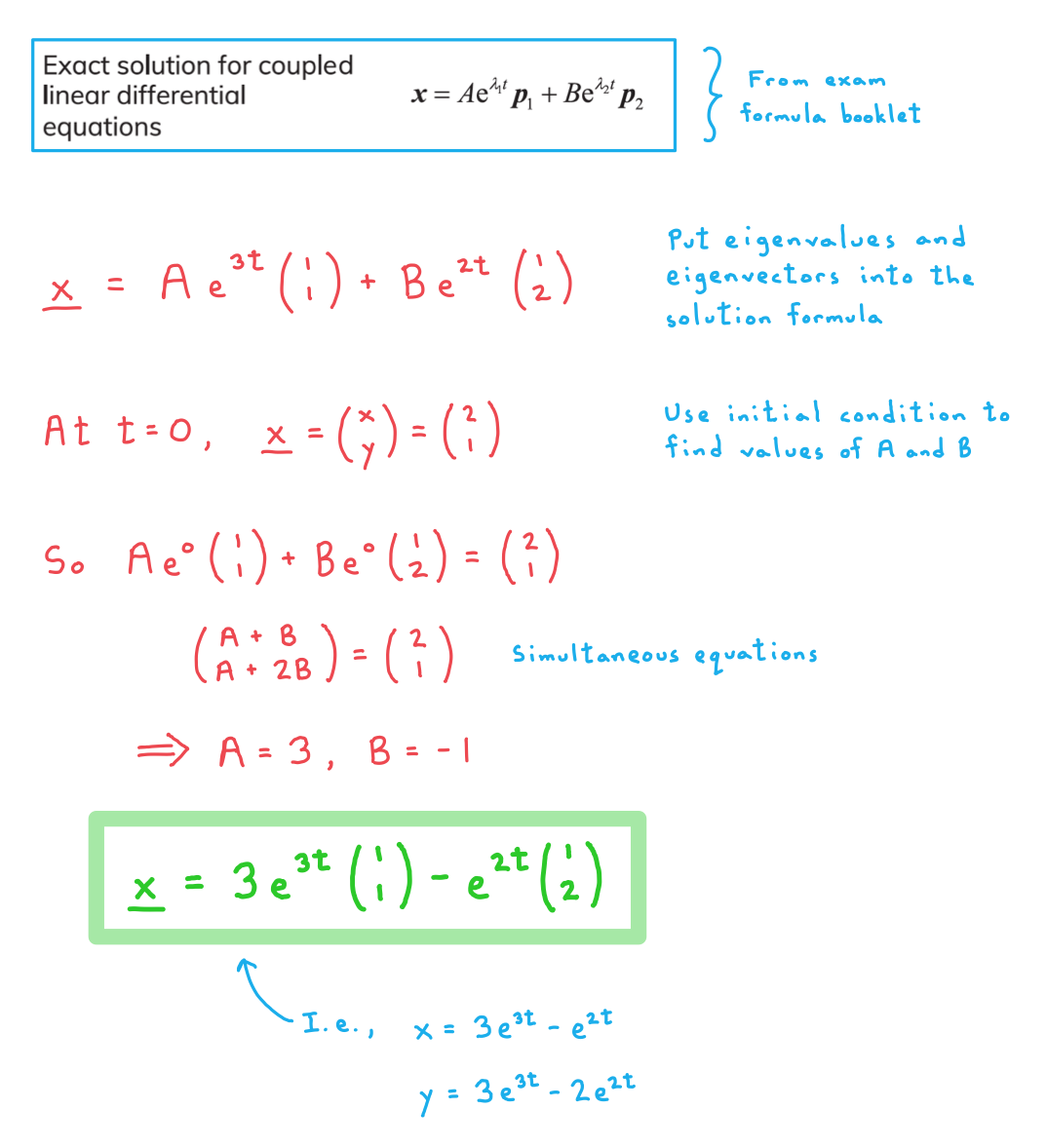
Phase Portraits
What is a phase portrait for a system of coupled differential equations?
- Here we are again considering systems of coupled equations that can be represented in the matrix form
, where
,
, and
- A phase portrait is a diagram showing how the values of x and y change over time
- On a phase portrait we will usually sketch several typical solution trajectories
- The precise trajectory that the solution for a particular system will travel along is determined by the initial conditions for the system
- Let
and
be the eigenvalues of the matrix
- The overall nature of the phase portrait depends in large part on the values of
and
What does the phase portrait look like when  and
and  are real numbers?
are real numbers?
- Recall that for real distinct eigenvalues the solution to a system of the above form is
, where
and
are the eigenvalues of
and
and
are the corresponding eigenvectors
- AI HL only considers cases where
and
are distinct (i.e.,
) and non-zero
- AI HL only considers cases where
- A phase portrait will always include two ‘eigenvector lines’ through the origin, each one parallel to one of the eigenvectors
-
- So if
and
, for example, then these lines through the origin will have equations
and
, respectively
- So if
- These lines will define two sets of solution trajectories
- If the eigenvalue corresponding to a line’s eigenvector is positive, then there will be solution trajectories along the line away from the origin in both directions as t increases
- If the eigenvalue corresponding to a line’s eigenvector is negative, then there will be solution trajectories along the line towards the origin in both directions as t increases
- No solution trajectory will ever cross an eigenvector line
-
- If both eigenvalues are positive then all solution trajectories will be directed away from the origin as t increases
- In between the ‘eigenvector lines’ the trajectories as they move away from the origin will all curve to become approximately parallel to the line whose eigenvector corresponds to the larger eigenvalue
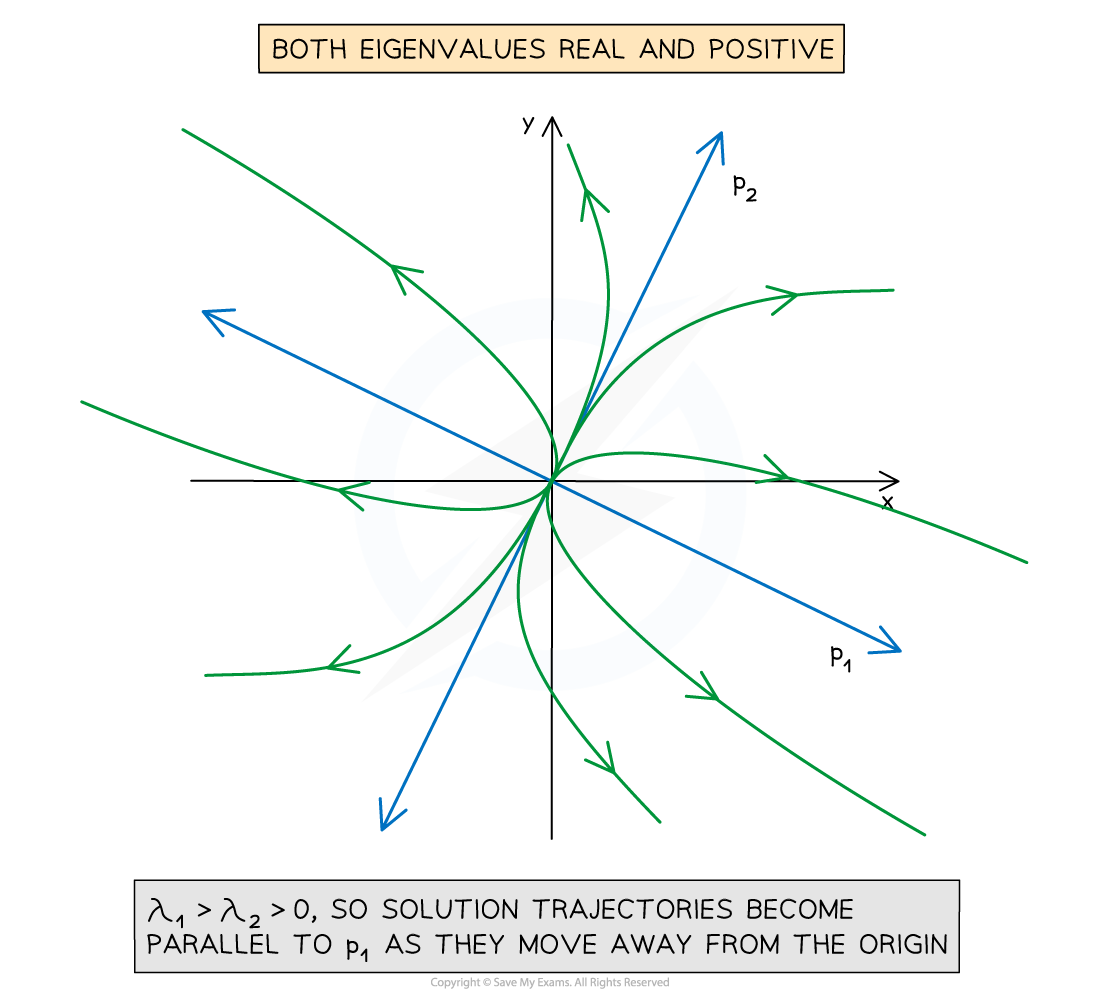
- If both eigenvalues are negative then all solution trajectories will be directed towards the origin as t increases
- In between the ‘eigenvector lines’ the trajectories will all curve so that at points further away from the origin they are approximately parallel to the line whose eigenvector corresponds to the more negative eigenvalue
- They will then converge on the other eigenvalue line as they move in towards the origin
- In between the ‘eigenvector lines’ the trajectories will all curve so that at points further away from the origin they are approximately parallel to the line whose eigenvector corresponds to the more negative eigenvalue
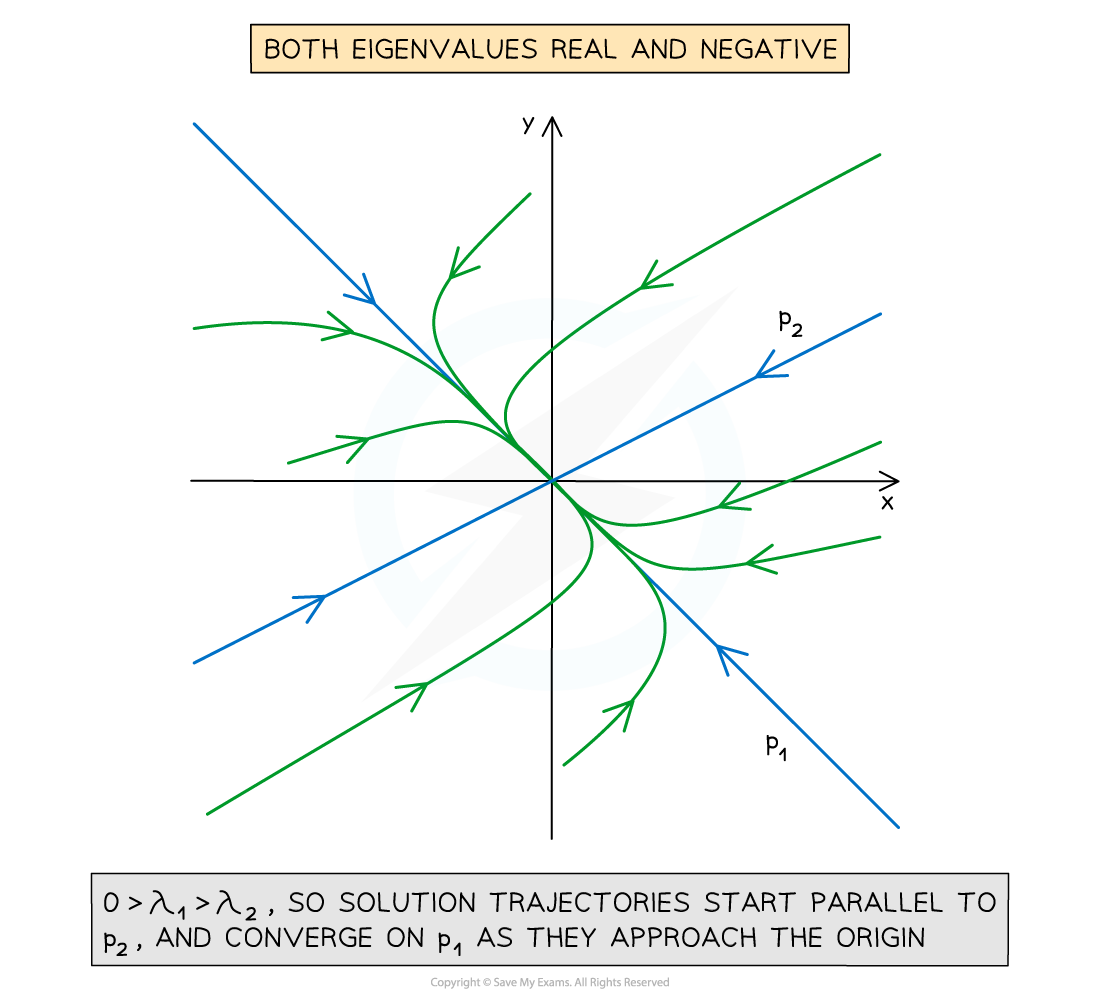
- If one eigenvalue is positive and one eigenvalue is negative then solution trajectories will generally start by heading in towards the origin before curving to head out away again from the origin as t increases
- In between the ‘eigenvector lines’ the solution trajectories will all move in towards the origin along the direction of the eigenvector line that corresponds to the negative eigenvalue, before curving away and converging on the eigenvector line that corresponds to the positive eigenvalue as they head away from the origin

What does the phase portrait look like when  and
and  are imaginary numbers?
are imaginary numbers?
- Here the solution trajectories will all be either circles or ellipses with their centres at the origin
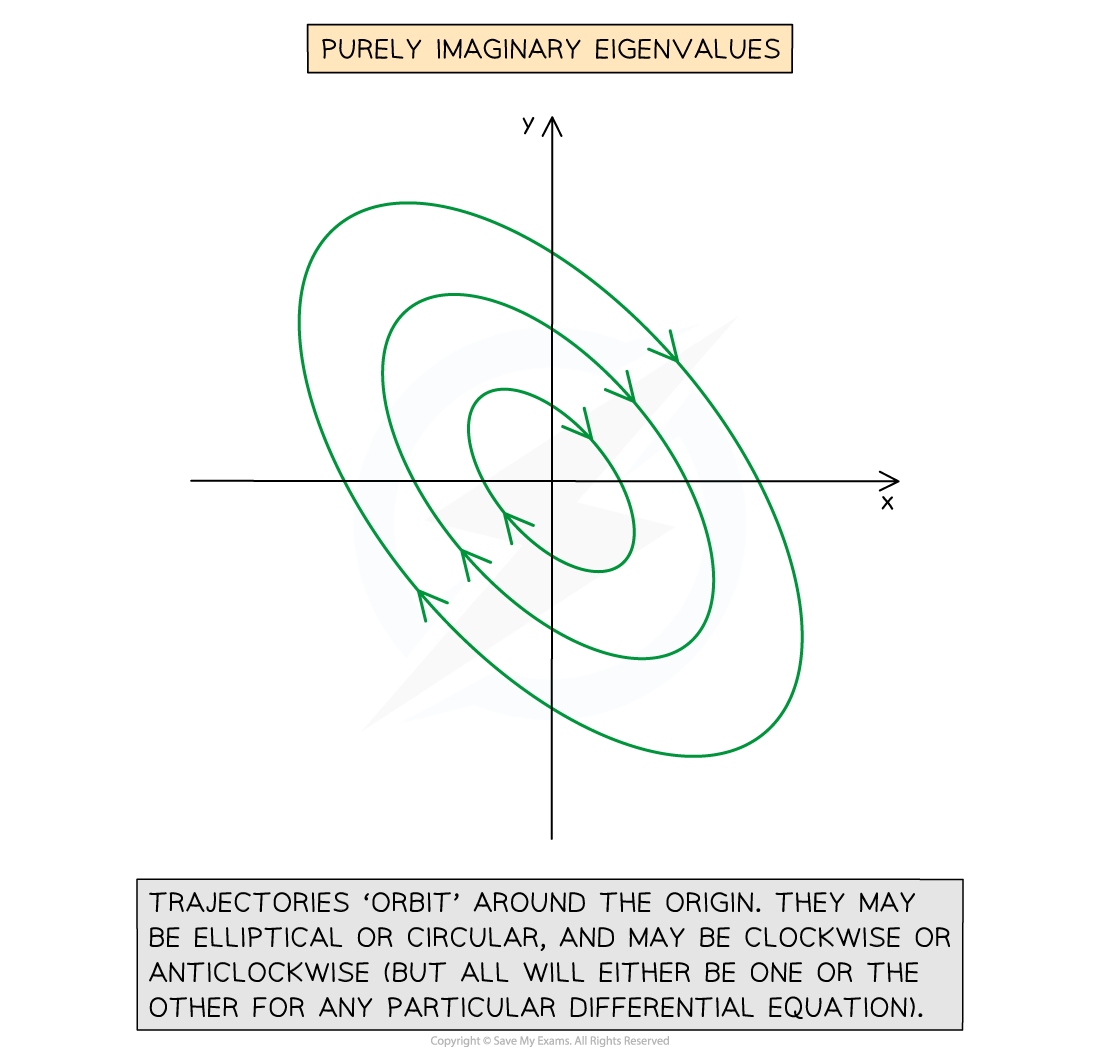
- You can determine the direction (clockwise or anticlockwise) and the shape (circular or elliptical) of the trajectories by considering the values of
and
for points on the coordinate axes
- For example, consider the system
- The eigenvalues of
are
and
, so the trajectories will be elliptical or circular
- When
and
,
and
- This shows that from a point on the positive
-axis the solution trajectory will be moving ‘to the right and up’ in the direction of the vector
- When
and
,
and
- This shows that from a point on the positive
-axis the solution trajectory will be moving ‘to the left and down’ in the direction of the vector
- The directions of the trajectories at those points tell us that the directions of the trajectories will be anticlockwise
- They also tell us that the trajectories will be ellipses
- For circular trajectories, the direction of the trajectories when they cross a coordinate axis will be perpendicular to that coordinate axis
What does the phase portrait look like when  and
and  are complex numbers?
are complex numbers?
- In this case
and
will be complex conjugates of the form
, where
and
are non-zero real numbers
- If
,
, then we have the imaginary eigenvalues case above
- Here the solution trajectories will all be spirals
- If the real part of the eigenvalues is positive (i.e., if
), then the trajectories will spiral away from the origin
- If the real part of the eigenvalues is negative (i.e., if
), then the trajectories will spiral towards the origin
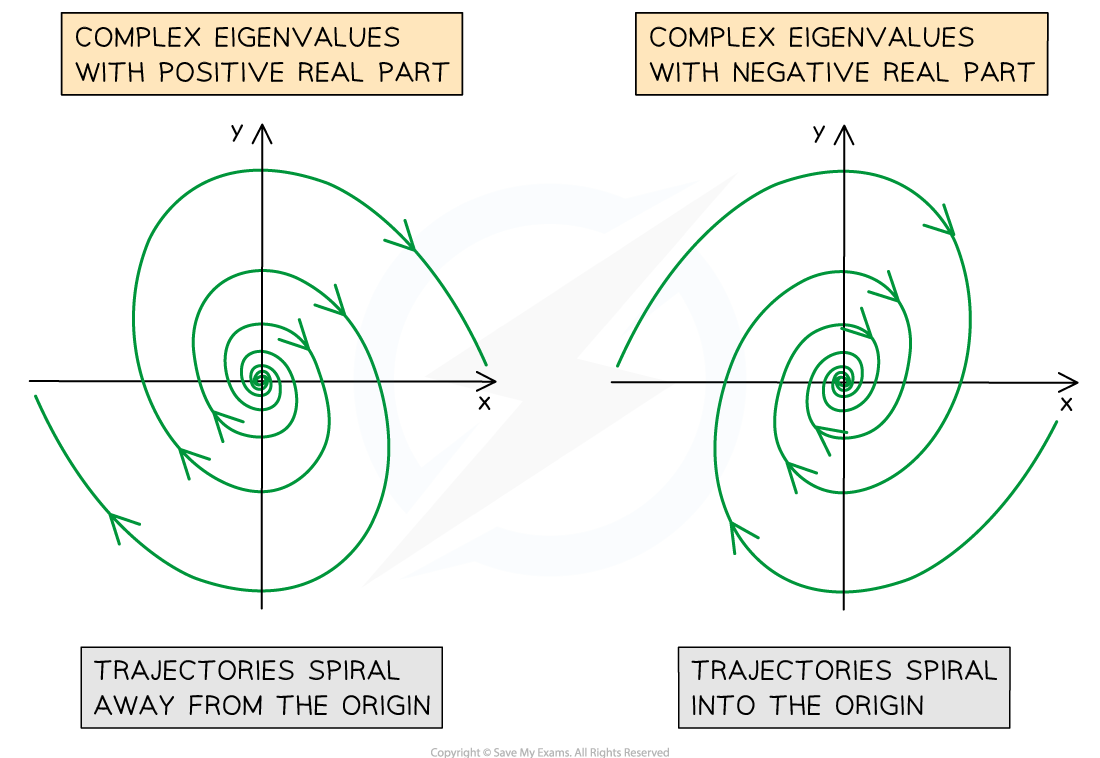
- You can determine the direction (clockwise or anticlockwise) of the trajectories by considering the values of
and
for points on the coordinate axes
- For example, consider the system
- The eigenvalues of
are
and
, so the trajectories will be spirals
- The eigenvalues of
- For example, consider the system
- Because the real part of the eigenvalues
is positive, the trajectories will spiral away from the origin
- When
and
,
and
- This shows that from a point on the positive
-axis the solution trajectory will be moving ‘to the right and down’ in the direction of the vector
- When
and
,
and
- This shows that from a point on the positive
-axis the solution trajectory will be moving ‘to the right and up’ in the direction of the vector
- The directions of the trajectories at those points tell us that the directions of the trajectory spirals will be clockwise
Worked Example
Consider the system of coupled differential equations
Given that and
are the eigenvalues of the matrix
, with corresponding eigenvectors
and
, draw a phase portrait for the solutions of the system.
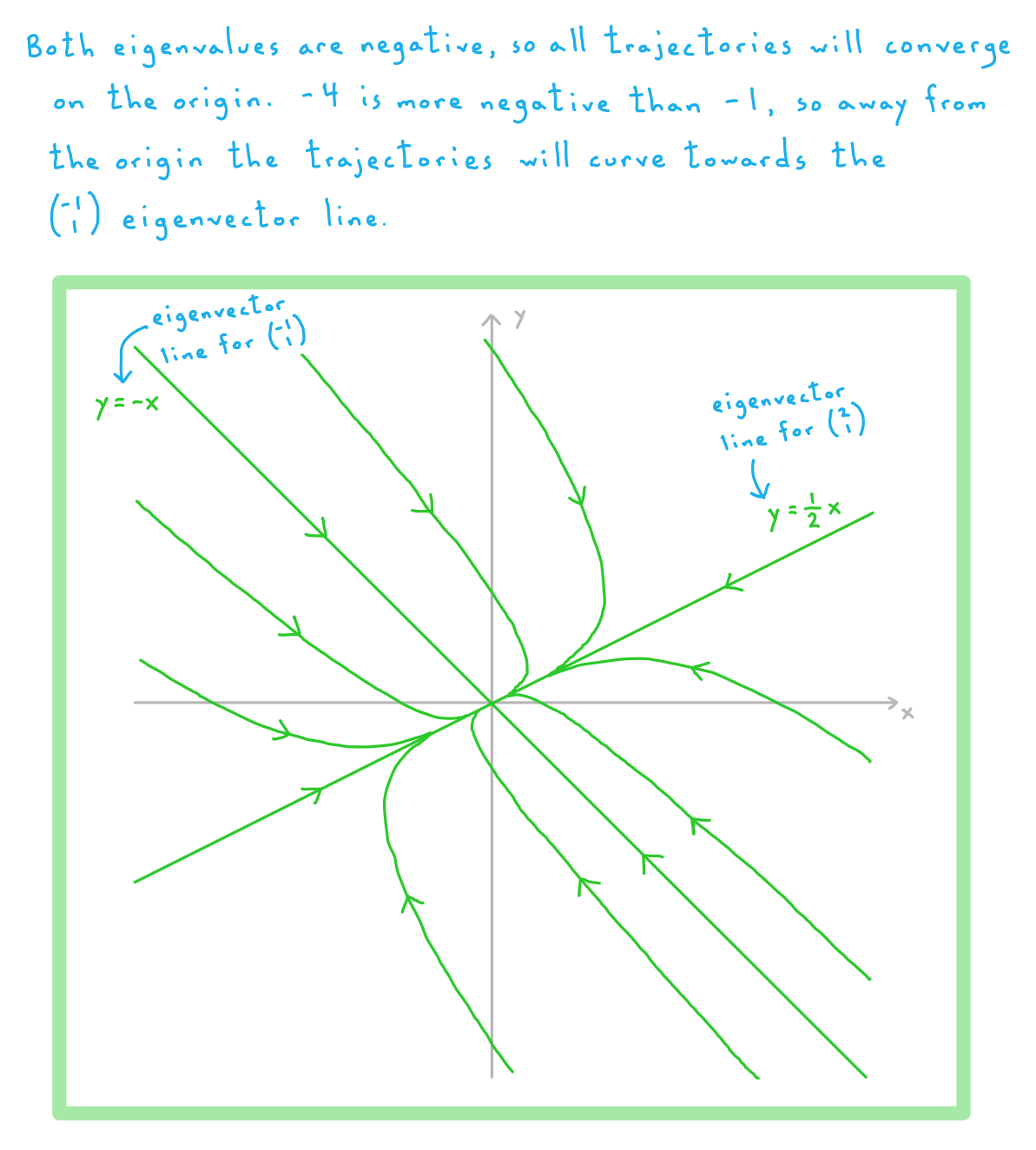
Equilibrium Points
What is an equilibrium point?
- For a system of coupled differential equations, an equilibrium point is a point
at which both
and
- Because both derivatives are zero, the rates of change of both
and
are zero
- This means that
and
will not change, and therefore that if the system is ever at the point
then it will remain at that point
forever
- An equilibrium point can be stable or unstable
- An equilibrium point is stable if for all points close to the equilibrium point the solution trajectories move back towards the equilibrium point
- This means that if the system is perturbed away from the equilibrium point, it will tend to move back towards the state of equilibrium
- If an equilibrium point is not stable, then it is unstable
- If a system is perturbed away from an unstable equilibrium point, it will tend to continue moving further and further away from the state of equilibrium
- For a system that can be represented in the matrix form
, where
,
, and
, the origin
is always an equilibrium point
- Considering the nature of the phase portrait for a particular system will tell us what sort of equilibrium point the origin is
- If both eigenvalues of the matrix
are real and negative, then the origin is a stable equilibrium point
- This sort of equilibrium point is sometimes known as a sink
- If both eigenvalues of the matrix
are real and positive, then the origin is an unstable equilibrium point
- This sort of equilibrium point is sometimes known as a source
- If both eigenvalues of the matrix
are real, with one positive and one negative, then the origin is an unstable equilibrium point
- This sort of equilibrium point is known as a saddle point (you will be expected to identify saddle points if they occur in an AI HL exam question)
- If both eigenvalues of the matrix
are imaginary, then the origin is an unstable equilibrium point
- Recall that for all points other than the origin, the solution trajectories here all ‘orbit’ around the origin along circular or elliptical paths
- If both eigenvalues of the matrix
are complex with a negative real part, then the origin is an stable equilibrium point
- All solution trajectories here spiral in towards the origin
- If both eigenvalues of the matrix
are complex with a positive real part, then the origin is an unstable equilibrium point
- All solution trajectories here spiral away from the origin
Worked Example
Show that is an equilibrium point for the system.
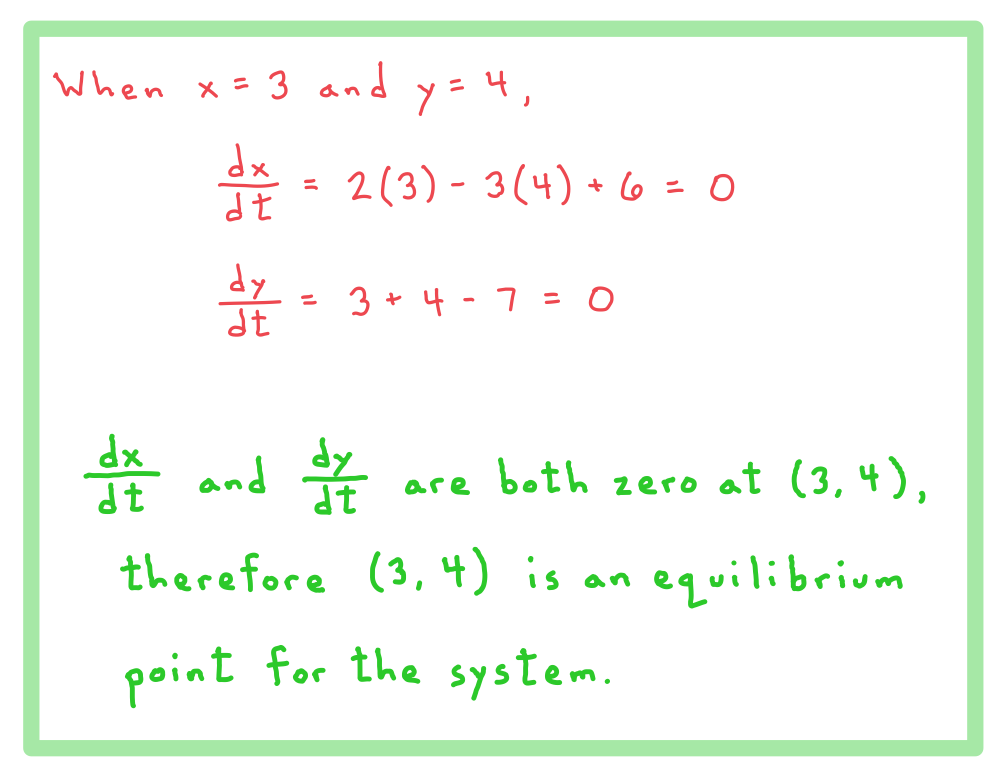
Given that and
are the eigenvalues of the matrix
, with corresponding eigenvectors
and
, determine the coordinates and nature of the equilibrium point for the system.
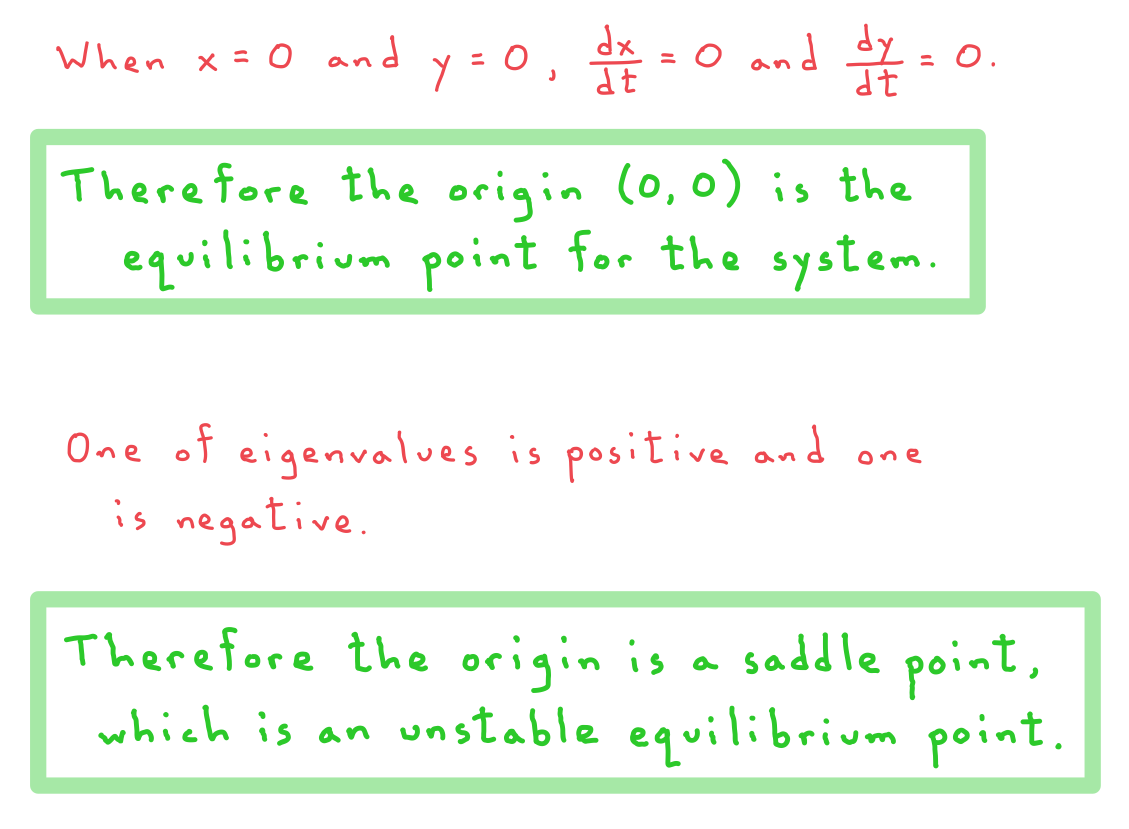
Sketching Solution Trajectories
How do I sketch a solution trajectory for a system of coupled differential equations?
- A phase portrait shows typical trajectories representing all the possible solutions to a system of coupled differential equations
- For a given set of initial conditions, however, the solution will only have one specific trajectory
- Sketching a particular solution trajectory will generally involve the following:
- Make sure you know what the ‘typical’ solutions for the system look like
- You don’t need to sketch a complete phase portrait unless asked, but you should know what the phase portrait for your system would look like
- If the phase portrait includes ‘eigenvector lines’, however, it is worth including these in your sketch to serve as guidelines
- Mark the starting point for your solution trajectory
- The coordinates of the starting point will be the
and
values when
- Usually these are given in the question as the initial conditions for the system
- Determine the initial direction of the solution trajectory
- To do this find the values of
and
when
- This will tell you the directions in which
and
are changing initially
- For example if
and
when
, then the trajectory from the starting point will initially be ‘to the left and up’, parallel to the vector
- Use the above considerations to create your sketch
- The trajectory should begin at the starting point (be sure to mark and label the starting point on your sketch!)
- It should move away from the starting point in the correct initial direction
- As it moves further away from the starting point, the trajectory should conform to the nature of a ‘typical solution’ for the system
Worked Example
Consider the system of coupled differential equations
The initial conditions of the system are such that the exact solution is given by
Sketch the trajectory of the solution, showing the relationship between and
as
increases from zero.
